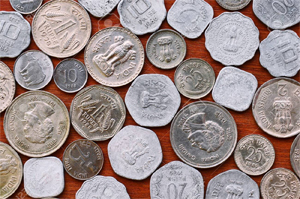At first glance, coins may appear to carry little historical information, but they provide clues to several important historical processes. Discuss with respect to Indian coins. (150 words)
Sakshi Education
By Srirangam Sriram, Sriram's IAS, New Delhi.

Before the advent of coins, barter exchange model was prevalent for trade and commerce. Coins simplified and removed the shortcomings associated with the barter system of exchange. Coins then were gradually imbibed into the economic system, which later on also became source of historical insight into the past.
Coins as source of historical information
Various types of historical information can be incurred from the study of coins. Some of these historical processes embedded in Indian coins are:
Economic History
Political History
Social and Cultural history 
The development of coins led to increased economic simplicity in everyday lives of people. But, the coins are not only attached to their economic value, rather they provide an insight into their period of use. This insight helps historians to extract out historical facts and events associated with the past society.

Before the advent of coins, barter exchange model was prevalent for trade and commerce. Coins simplified and removed the shortcomings associated with the barter system of exchange. Coins then were gradually imbibed into the economic system, which later on also became source of historical insight into the past.
Coins as source of historical information
Various types of historical information can be incurred from the study of coins. Some of these historical processes embedded in Indian coins are:
Economic History
- Coins are linked to monetary history, which includes production and circulation of coinage, the monetary values attached to coins and frequency of volume of issues.
- Coins provide an insight into history of exchange and trade. The wide distribution of Kushana coins indicate the flourishing trade of the period. Ship on certain Satavahana coins reflect the importance of maritime trade in the Deccan. Roman coins found in various parts of India provide information on Indo-Roman trade.
- Coins are often taken to indicate levels of economic prosperity or the lack of it or financial condition of ancient states. Historians interpret debasement of coins as an indication of financial crisis.
Political History
- Coins form an important source for political history between c.200 BCE and c.300 CE. Most of the Indo-Greek kings are almost known entirely from their coins. Coins also offer information on Parthians, Shakas, Kshatrapas, Kushanas and Satavahanas.
- Area of circulation of dynastic issues is often used to estimate the extent and frontiers of empires.
- Coins offer information on ancient political systems. The term ‘Gana’ on coins of Yaudheyas and Malavas points to their non-monarchical polity.
- City coins are suggestive of importance and possible autonomy of certain city administrations.
- Sometimes, coins offer specific detail about rulers such as marriage of Gupta king Chandragupta I with Lichchhavi princess and performance of Ashvamedha sacrifice by Samudragupta.
Social and Cultural history
- Coins depict history of languages and scripts.
- Coins often help date the historical events.
- Depiction of deities on coins provides information about personal religious preferences of Kings, royal religious policy and history of religious cults. For instance, depiction of great variety of figures from Indian, Iranian and Graeco-Roman religious traditions on the coins of Kushana kings is generally interpreted as a reflection of their eclectic religious views.

The development of coins led to increased economic simplicity in everyday lives of people. But, the coins are not only attached to their economic value, rather they provide an insight into their period of use. This insight helps historians to extract out historical facts and events associated with the past society.
Published date : 26 Oct 2020 01:25PM













